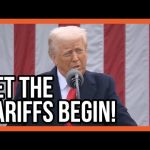President Trump is preparing to make a significant announcement in the Rose Garden, and the anticipation is palpable. Markets are on edge, diplomats are on speed dial, and the political pundits are tapping into their wildest theories trying to decode what could be a monumental shift in American trade policy. Just about everyone seems to be guessing about what the President will unveil, and that’s precisely the point.
Dubbed “Liberation Day,” Trump’s upcoming announcement is not just another routine pronouncement; it’s a game-changer. For weeks, hints have been dropped about a new tariff regime that is likely to be comprehensive—20 percent across the board? A reciprocal system that mirrors foreign rates? The precise nature remains cloaked in mystery, but that ambiguity serves a purpose. It creates leverage at a time when America is ready to reclaim its rightful place in global trade.
Liberation Day and the End of the World‘s Trade War Against America.https://t.co/QFnZmLvZy9
— CombsJC (@RedState66) April 2, 2025
In stark contrast to the chaotic ditherings of the Beltway insiders, one must appreciate the deliberate choreography of Trump’s announcement. Rather than chaotic disarray, it’s a well-practiced performance with Trump at the helm. Balancing on the tightrope of economic negotiation, Trump emerges not only as a politician but also as a master showman who instinctively understands how to turn policy into must-see TV.
The underlying issue is crystal clear: the international trading system is rigged against the United States. While mainstream media fixates on minor factions within the administration, the damage to American workers from flawed trade policies has been documented for decades. The economic justification for aggressive new tariffs is not just sound—it’s resoundingly simple. The VAT regime in Europe, which allows foreign automakers to export cars to the U.S. tax-free while American automakers face dual taxation, is a glaring example of an uneven playing field. It’s no surprise that the World Trade Organization remains indifferent while American efforts to rectify this imbalance are met with brick walls.
Trump’s advisors have suggested a tariff as high as 25 percent on European goods. Unlike punitive tariffs, this would be more akin to compensation for the buried taxes American producers endure, aiming to neutralize the VAT advantage held by foreign competitors. The goal? To tilt the scales back in favor of American workers and signpost that the era of unchallenged foreign advantages is over.
The long-held belief that tariffs are detrimental to the economy is rooted in outdated thinking from a century ago, often cited but seldom examined critically. The reality is that America thrived under higher tariffs in the past; the Great Depression stemmed from monetary crises rather than trade barriers. The so-called free trade agreements touted today do little to counteract state-sponsored subsidies and currency manipulations that suffocate American industry.
Advocates for national security highlight the critical link between a vibrant industrial economy and military strength. Without a robust manufacturing base, the U.S. risks losing its ability to maintain military primacy as well as economic independence. For businesses to thrive, they need certainty—tariffs offer that certainty without the red tape that central planning brings.
Liberation Day signals more than just an announcement; it represents a turning point. After decades of passively absorbing international trade shocks for the supposed greater good, Trump’s first term shattered that complacent consensus. His second term is on the cusp of cementing a new reality.
Amid the noise and concern over Trump’s tariff strategy, there’s a poignant reminder from history. Agents of discord may chant for peace while ignoring the reality of ongoing economic warfare already waged against America. With this upcoming announcement, Trump aims to validate the notion that the battle for fair trade has indeed been underway—it just hasn’t been fought from the front lines until now.
If the tariffs introduced are comprehensive, high, and sustainable—essential qualities—they’ll give American businesses the assurance they need to invest domestically. Should they be structured to encourage reciprocity, it will compel trading partners to confront their own unfair practices. No matter the final outline, one thing is certain: the old rules are about to be tossed aside like yesterday’s newspaper.
Anyone banking on this being another false alarm might want to rethink that strategy. Trump has committed too much to back out quietly now; the upcoming Liberation Day will go down as the moment America resolved not to finance its own downfall any longer—neither through taxation nor trade appeasement. It’s time for the U.S. to take a stand and start pushing back against the forces that have, for far too long, compromised American workers and industries alike.




